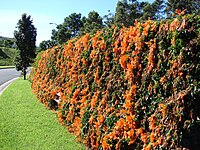| Pyrostegia venusta | |
|---|---|

| |
| Scientific classification | |
| Kingdom: | Plantae |
| Clade: | Tracheophytes |
| Clade: | Angiosperms |
| Clade: | Eudicots |
| Clade: | Asterids |
| Order: | Lamiales |
| Family: | Bignoniaceae |
| Genus: | Pyrostegia |
| Species: | P. venusta |
| Binomial name | |
| Pyrostegia venusta (Ker Gawl.)Miers | |
| Synonyms | |
| |

Pyrostegia venusta, also commonly known as flamevine or orange trumpet vine, is a plant species of the genus Pyrostegia of the family Bignoniaceae originally native to southern Brazil, Bolivia, northeastern Argentina and Paraguay; today, it is also a widely cultivated garden species.
Description
It is an evergreen or semi-deciduous, vigorously-growing climber, capable of reaching 5 m in height. The foliage is made up of opposite, pinnate leaves with two or three, 4 to 8 cm leaflets, and a 3-branched tendril, which all arise together from the end of the leaf petiole.
The orange flowers, which appear from winter to spring, are 5 to 9 cm long and densely clustered. They are pollinated by hummingbirds. The fruits are smooth, 3 cm long brown capsules.
Cultivation
The plant is sensitive to cold winds and prefers sunny, sheltered locations. Its frost hardiness USDA zones are 9 to 11. It is resistant to soil salinity.
The plant has forked tendrils, which will cling to any rough surface, including brick walls. It can be grown from semi-hardwood cuttings taken in summer, autumn or winter.
It is naturalised in eastern Australia, eastern Africa and in the southeastern United States.
Taxonomic history
The species was first described by John Miers in 1863.
Etymology
Venusta means 'beautiful', 'charming', or 'graceful'. "Pyrostegia" is from the Greek pyros 'fire', relating to the colour of the flowers and the shape of the upper lip, and stegia 'covering'. When the flowers cover a building, it may appear to be on fire.

References
- The Plant List: A Working List of All Plant Species, retrieved 8 September 2016
- NRCS. "Pyrostegia venusta". PLANTS Database. United States Department of Agriculture (USDA). Retrieved 16 October 2015.
- ^ "Pyrostegia venusta". Germplasm Resources Information Network. Agricultural Research Service, United States Department of Agriculture. Retrieved 7 October 2006.
- Proceedings of the Royal Horticultural Society of London 3:188. 1863
- Orange Trumpet Creeper by Burke's Backyard
- Pyrostegia venusta by Weeds of Australia - Biosecurity Queensland Edition
- Gledhill, David (2008). "The Names of Plants". Cambridge University Press. ISBN 9780521866453 (hardback), ISBN 9780521685535 (paperback). pp 322, 399
External links
 Media related to Pyrostegia venusta at Wikimedia Commons
Media related to Pyrostegia venusta at Wikimedia Commons
| Taxon identifiers | |
|---|---|
| Pyrostegia venusta |
|
| Bignonia venusta | |
This Bignoniaceae article is a stub. You can help Misplaced Pages by expanding it. |